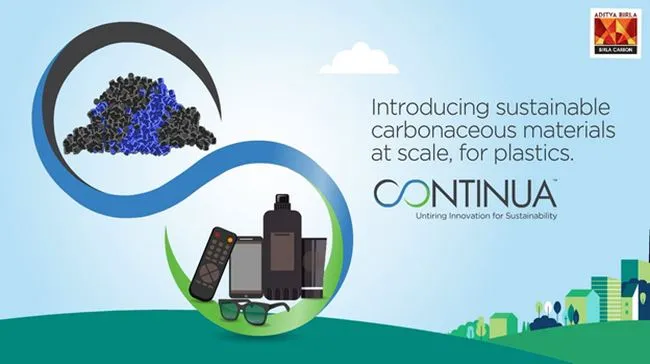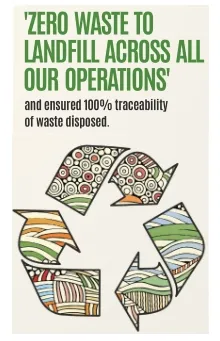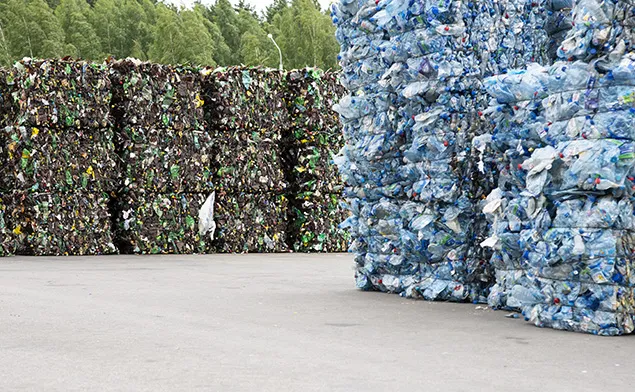Closing the Loop
- Copy

Industry's biggest challenge today is meeting the needs of nearly 8 billion people without neglecting the needs of the planet. The solution lies in developing a 'circular economy' to mitigate environmental degradation and climate change. Forward-thinking corporates like the Aditya Birla Group are increasingly integrating circularity into their businesses.
The traditional linear economy, or the ‘make, use, dispose’ model has over-strained and polluted Earth’s finite resources. The circular economy, by contrast, focuses on ‘make, use, return’.
The Ellen MacArthur Foundation, which works with multiple Group companies on circularity initiatives, outlines three guiding principles: Eliminate waste in production, circulate products and materials in use, and regenerate natural systems.
On all these fronts, Group companies have adopted regenerative and restorative business practices that contribute to key 2030 Sustainable Development Goals (SDGs), including SDG 12 (Sustainable consumption and production), SDG 6 (Water management), SDG 7 (Affordable and clean energy), SDG 13 (Climate action), and others.
Here are some of the circular economy initiatives at ABG.
Circularity through innovation
Design innovation sits prominently at the heart of the circular economy, ensuring that products can be upcycled or reused at the end of their life. Multiple Group companies are today using circularity design principles to create more sustainable products.
For instance, Continua™ 8000, a sustainable carbonaceous material (SCM) made by Birla Carbon has a carbon footprint that is significantly lower than traditional furnace carbon black products. Carbon black, which is often used in finished rubber and plastic products, is very hard to separate from other materials. However, Continua™ 8000, made from end-of-life tyres, is a next-generation SCM product designed to re-enter the economy as tyres, plastics, and rubber compounds, thus closing the circular loop.
Greener textiles
Another example is Birla Cellulose's Liva Reviva fibre. Made with 20 percent industrial cotton waste and 80 percent wood pulp from sustainable forests, Liva Reviva is a circular textile product whose quality is comparable to fibres made with virgin wood pulp.
Birla Cellulose, which developed Liva Reviva, has already sold the fibre to 20 global brands.
As the next step in its circularity journey, the Birla Cellulose R&D team is working on products made with over 50 percent of industrial fabric waste and postconsumer clothing as inputs.

Waste to wealth
Aditya Birla Fashion and Retail Ltd. (ABFRL) has adopted waste reduction and 'zero waste to landfill' as key goals to proactively manage its own production waste and encourage circularity in the apparel business.
The progress on both fronts is impressive. While the fashion major recycles and reuses 90 percent of its waste, the second goal has already been fully achieved, with none of its facilities sending any waste to landfills last year. The company also conducts rigorous waste traceability assessments to validate and certify the disposal mechanism of waste till the last mile.
That's not all. Sustainability at Aditya Birla Fashion and Retail is not just an activity; it's an approach for business growth. As part of its Sustainability 2.0 strategy, the company will ensure that half of its products by volume (from around 40 percent now) have at least one sustainability attribute by 2025.
The company will also put more used apparel back into circulation by recycling or upcycling 10 percent of its products. In parallel, it is testing and developing newer circular innovations in partnership with the Circular Apparel Innovation Factory.
Can-to-can cycle
Another great example of putting waste back in circulation comes from Hindalco subsidiary Novelis Inc. With an unmatched commitment to sustainability, Novelis is the leading buyer and recycler of used beverage cans globally – recycling more than 74 billion cans annually. Its closed-loop technology allows it to turn a used aluminium can into a brand-new one in just 60 days.
Preserving natural capital
The industrial processes generate by-products that can be hazardous for the environment. One of these is bauxite residue (also known as red mud), which is left over after bauxite is processed to make aluminium.

To ensure that its red mud residue doesn't end up polluting the environment, Hindalco has collaborated with cement manufacturers who can use it as an input. A unique filtration technique is utilised to remove moisture from the red mud, enhancing its usability.
Within a year, Hindalco upped its utilisation of red mud from 27 percent in FY2019-20 to 62 percent in FY2020-21. The company also ensured that 90 percent of its fly ash (fine residue from coal combustion) was reused in the cement, construction, and brick industries, besides other applications.
Waste as value
Cement major UltraTech, one of the earliest proponents of alternative fuels and other environmental practices among cement manufacturers in India, uses large amounts of waste – from industrial, mining, and agricultural waste to municipal solid waste – to reduce its reliance on natural raw materials. In fact, the company actively explores fresh 'waste streams' each year and equips its plants with technologies to process newer kinds of waste.
In the last decade, the company has used 533,867 metric tonnes of industrial waste to produce blended cements or as alternative fuels. And in FY2020-21, it turned 74,187 tonnes of municipal solid waste, including plastic, into fuel for its cement kilns, preventing all that waste from clogging public landfills.
More such inspiring stories of circularity abound at the Aditya Birla Group. As one of India's most sustainability-focused businesses, the Group's commitment to the circular economy is part of its vision of driving future-proof, sustainable, and inclusive growth.
Mr. Sandeep Gurumurthi
Group Head, Communication & Brand
Aditya Birla Management Corporation Pvt. Ltd.
Call: +91-22-6652-5000 / 2499-5000
Fax: +91-22-6652-5741 / 42

















